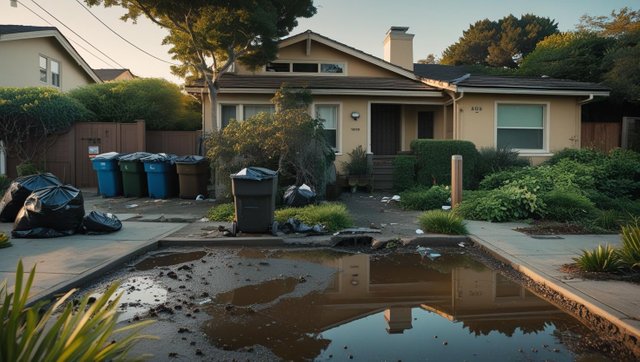What Attracts Pests to Bay Area Properties (And How to Stop It)
Pest problems don’t happen randomly. Ants, rodents, cockroaches, and other intruders follow specific patterns—and most of them start with how your property is managed. Whether you’re in Alameda, Marin, or Santa Clara County, understanding what draws pests to your space is the first step in keeping them out.
This article breaks down the most common attractants across homes, businesses, and municipal facilities in the Bay Area, and shows you how to address them before they turn into infestations.
- Food Waste and Improper Storage
Every pest species needs food. The easier it is to access, the faster they move in.
Common issues in homes and businesses:
Crumbs or spills under appliances
Unsealed pantry goods
Trash bins without lids
Pet food left out overnight
Grease buildup in commercial kitchens
How to prevent it:
Wipe surfaces and sweep floors daily
Store food in airtight containers
Empty trash and recycling regularly
Use tight-fitting lids indoors and outdoors
Clean under ovens, fridges, and shelving units weekly
In high-traffic areas, like restaurants or school cafeterias, partnering with a trusted service like ATCO Pest Control can help monitor and manage risk zones.
- Water and Moisture Sources
Most pests need water to survive. Leaks, humidity, and standing water are magnets.
Common water-related problems:
Dripping faucets and outdoor hoses
Roof or gutter leaks
Damp crawlspaces or basements
Overwatered landscaping
Condensation on pipes or windows
How to prevent it:
Fix plumbing leaks quickly
Install dehumidifiers in damp zones
Clear gutters and downspouts each season
Adjust irrigation to avoid puddles near the structure
Use splash blocks to direct water away from foundations
Rodents and insects often follow moisture to indoor hiding spots. Early detection and ongoing inspection by professionals like ATCO Pest Control can help you identify unseen water issues before pests do.
- Structural Entry Points
Pests don’t need a large hole to get inside. Mice can fit through openings the size of a dime. Insects need even less.
Typical building gaps:
Cracks in siding or foundation
Gaps around utility lines
Unsealed roof joints and attic vents
Broken window screens
Poorly sealed doors or loading docks
How to prevent it:
Install door sweeps and weather stripping
Seal foundation and siding cracks with caulk
Repair or replace vent screens
Use pest-resistant mesh around pipes and openings
Inspect utility entry points at least once per season
Pest-proofing like this helps both homes and facilities avoid unplanned infestations. Municipal and commercial property managers across Contra Costa and San Francisco Counties often contract ongoing support from teams like ATCO Pest Control to stay ahead of structural vulnerabilities.
- Clutter and Shelter
Once pests find food and water, they look for safe places to live and breed. Clutter gives them what they need.
Where clutter attracts pests:
Stacks of cardboard boxes in garages or storerooms
Dense landscaping or overgrown shrubs
Junk piles near walls or fences
Unused furniture or mattresses stored improperly
Attics or basements filled with uninspected storage
How to prevent it:
Eliminate unnecessary storage near entry points
Keep yards trimmed and vegetation away from buildings
Store belongings in sealed plastic bins, not cardboard
Rotate or inspect stored items twice per year
Maintain clear access paths in storage rooms and sheds
Cockroaches, silverfish, rats, and spiders thrive in undisturbed areas. Staying organized reduces your risk—and makes it easier to spot early activity.
- Light and Heat
Certain pests are drawn to light or warmth, especially at night. While these attractants are harder to eliminate, you can reduce their impact.
Light and heat attract:
Flying insects like moths and beetles
Spiders that feed on those insects
Rodents looking for heat from appliances or HVAC units
How to prevent it:
Use yellow “bug lights” in exterior fixtures
Turn off unnecessary outdoor lighting overnight
Keep light fixtures away from doorways
Seal openings near appliances or water heaters
Maintain equipment to avoid excess heat or odors
This is especially important for commercial and municipal buildings with round-the-clock lighting. A professional pest team can recommend low-impact lighting strategies to reduce attraction.
- Poor Waste Management
Dumpsters, bins, compost, and recycling stations are major risk areas.
Waste-related pest problems:
Overflowing bins
Food waste in open compost piles
Missed or delayed trash pickups
Grease bins or oil drums left uncovered
Recyclables stored without rinsing
How to prevent it:
Place bins on hard surfaces away from walls
Use lids that latch or lock
Rinse containers before recycling
Schedule consistent waste removal
Sanitize bins regularly
These steps are especially important in shared environments like apartment buildings, food prep facilities, and parks. Many commercial properties in Solano and Santa Clara Counties rely on scheduled pest servicing alongside routine waste management.
- Seasonal Factors and Landscaping
Pest pressure increases when landscaping is unmanaged or maintenance is skipped seasonally.
Attractants in yards and green spaces:
Tree limbs touching roofs or siding
Wood piles stacked against exterior walls
Mulch layers deeper than 3 inches
Uncovered compost or garden beds near structures
How to prevent it:
Trim branches back at least 3 feet from structures
Store firewood at least 20 feet away
Use gravel or stone instead of deep mulch in pest-prone zones
Install rodent guards on fencing or garden beds
Keep grass trimmed and leaf litter under control
Properties near wooded areas or open fields in counties like Sonoma and Marin need consistent exterior management. Companies with local experience can recommend targeted changes based on neighborhood activity.
A Smarter Pest Strategy Starts with Awareness
You don’t have to wait for pests to show up. Most infestations happen due to environmental factors that are easy to address. Once you identify the attractants, you can:
Make targeted changes to reduce risk
Train staff or residents on prevention
Schedule inspections to track progress
Act early if pest signs appear
Working with a qualified, Diamond Certified company ensures you're getting recommendations tailored to your building type, location, and risk profile.
